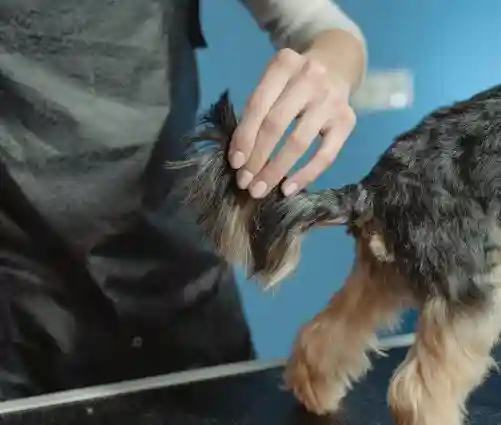Welcome to our detailed guide on “dog bite tail.” Dogs are beloved companions, but understanding their behavior, especially when it comes to potential dangers like dog bites, is crucial. In this article, we will explore everything related to dog bite tails, from prevention to handling such incidents.
What is a Dog Bite Tail?
Understanding the term is essential before delving deeper. A “dog bite tail” refers to an incident where a dog bites its tail, or in some cases, a dog biting another dog’s tail. This behavior can have various causes, and it’s vital to address them appropriately.
Dog Chew Tail Raw: Causes of Dog Bite Tail Incidents
Dogs may bite their tails for several reasons: Parasites can be a significant factor in causing dogs to bite or chew on their tails. How parasites can lead to this behavior:
- Fleas and Ticks: Fleas and ticks are common external parasites that infest dogs. These tiny insects can bite and irritate the dog’s skin, including the tail area. In response to the discomfort and itching caused by flea or tick bites, a dog may start biting and chewing its tail in an attempt to alleviate the itching. This can lead to hair loss, sores, and even secondary bacterial infections.
- Mange: Mange is a skin condition caused by mites that burrow into the dog’s skin. Sarcoptic mange (scabies) and Demodectic mange are two types that can affect a dog’s tail. These mites can cause intense itching, redness, and hair loss. Dogs may bite or chew their tails to relieve the itching, exacerbating the problem.
- Internal Parasites: Some internal parasites, such as tapeworms, can cause anal irritation in dogs. When a dog experiences discomfort or itching around the anal area, it may resort to tail-biting as a way to relieve the irritation.
- Allergic Reactions: In some cases, dogs can be allergic to the saliva of fleas and other parasites. This can lead to an allergic skin reaction called flea allergy dermatitis. Dogs with this condition often exhibit intense itching, which can extend to the tail area, prompting them to bite or chew their tails.
- Secondary Infections: Continuous tail-biting can break the skin and create open wounds. These wounds are susceptible to bacterial infections, which can further worsen the dog’s discomfort and itching. This can create a cycle where the dog bites its tail due to irritation from parasites, leading to secondary infections, which in turn cause more itching and biting.
- Environmental Allergies: Environmental allergies in dogs, often referred to as atopic dermatitis or atopy, occur when a dog’s immune system reacts to substances in the environment. These allergens can include pollen, dust mites, mold spores, and certain chemicals. Here’s a more detailed explanation of environmental allergies in dogs:
- Symptoms: Dogs with environmental allergies typically exhibit skin-related symptoms. Common signs include itching (pruritus), redness, inflamed skin, hair loss, and recurrent ear infections. Itching can be intense and may lead to the dog scratching, licking, or chewing at various parts of its body, including the paws, face, belly, and, of course, the tail.

- Itchiness: An itchy tail can lead to self-biting.
- Infection or Injury: Dogs may bite their tails when they’re injured or have an infection.
- Stress or Anxiety: Like humans, dogs can exhibit stress through destructive behaviors.
- Boredom: Lack of mental stimulation can lead to tail biting.
- Compulsive Behavior: Some dogs develop compulsive disorders, leading to tail-chasing.
What does it mean when a dog bites its tail?
It’s essential to spot the signs of a dog bite tail incident early on to provide timely care:
- Excessive Dog Tail Chasing: Frequent and obsessive tail chasing.
- Visible Injury or Blood: If you notice blood or injuries on the tail.
- Restlessness: Dogs in distress may exhibit restlessness.
- Loss of Fur: Hair loss around the tail area can indicate a problem.
- Whimpering or Yelping: Vocalization due to pain or discomfort.
Preventing Dog Bite Tail Incidents
Prevention is key to keeping your furry friend safe:
- Regular Vet Visits: Schedule routine check-ups to address health issues.
- Provide Mental Stimulation: Keep your dog engaged with toys and activities.
- Address Anxiety: If your dog is anxious, consult a professional for guidance.
- Grooming: Proper grooming can prevent skin issues that lead to tail biting.
- Training: Enroll in obedience classes to address behavioral problems.
What to Do If Your Dog Bites Its Tail
If your dog has bitten its tail, take the following steps:
- Stay Calm: Your dog can sense your emotions; stay composed.
- Assess the Injury: Check for bleeding or visible damage.
- Consult a Vet: Seek immediate veterinary attention if needed.
- Address Underlying Causes: Work with a professional to tackle behavioral issues.
Excessive Dog Tail Chasing: Frequent and Obsessive Tail Chasing
Excessive tail chasing refers to a behavior where a dog continuously and obsessively spins in circles, chasing its tail. This behavior can range from occasional playfulness to persistent and compulsive actions. When a dog repeatedly chases its tail, it may indicate underlying issues such as anxiety, boredom, or compulsive disorders. It’s crucial to differentiate between occasional tail chasing, which can be normal play behavior, and the obsessive variety, which often requires intervention.
Visible Injury or Blood: Noticing Blood or Injuries on the Tail
If you observe blood or injuries on your dog’s tail, it’s a clear sign of a problem. Tail injuries can occur due to accidents, rough play, or even aggressive encounters with other animals. In some cases, excessive tail biting or chewing can lead to self-inflicted wounds, which may become infected if left untreated. It’s essential to inspect your dog’s tail regularly for any signs of injury and seek prompt veterinary care if you notice bleeding or visible wounds.
Restlessness: Dogs in Distress May Exhibit Restlessness
Restlessness in dogs is a behavioral sign that can be indicative of various issues, including tail discomfort. When a dog is in distress due to tail-related problems such as itching, pain, or injury, they may exhibit restlessness. Restless behaviors can include pacing, inability to settle, or constant fidgeting. If your dog appears unusually restless, especially if it coincides with other signs like tail biting, it’s essential to consult with a veterinarian to determine the underlying cause and appropriate treatment.
Loss of Fur: Hair Loss Around the Tail Area Can Indicate a Problem
Hair loss, or alopecia, around the tail area, can be a noticeable symptom of tail biting or tail chewing. Dogs may bite or chew their tails so vigorously that they cause hair to fall out, leaving bald patches. While occasional hair loss can occur during normal grooming or play, significant and persistent hair loss in the tail region should be investigated. It could be linked to skin allergies, parasites, infections, or compulsive behaviors, all of which require professional assessment and intervention.
Whimpering or Yelping: Vocalization Due to Pain or Discomfort
Whimpering or yelping is a vocalization that dogs use to communicate distress, pain, or discomfort. If a dog is experiencing tail-related problems, such as an injury, infection, or severe itching, they may vocalize in response to the pain or discomfort they are feeling. Whimpering or yelping should be taken seriously, as it indicates that your dog is in distress. In such cases, it’s crucial to consult with a veterinarian promptly to determine the cause of the distress and provide appropriate care and pain management.
Conclusion
Understanding the nuances of “dog bite tail” incidents is essential for responsible pet ownership. By recognizing the signs, preventing issues, and knowing how to react, you can ensure your canine companion leads a happy and healthy life. Stay informed and keep your furry friend safe!
Frequently Asked Questions (FAQs)
Can tail-biting be a sign of a serious health problem?
Yes, it can indicate underlying health or behavioral issues. Consult a vet for a proper diagnosis.
How can I prevent my dog from biting its tail?
Provide mental stimulation, groom regularly, and address anxiety or stress through professional guidance.
Is tail-chasing normal puppy behavior?
Occasional tail-chasing is normal, but excessive or obsessive behavior should be addressed.
Can I treat my dog’s tail injury at home?
Minor injuries may be treated at home, but consult a vet for proper guidance.
Is there a connection between tail-biting and aggression?
Tail-biting can sometimes be a sign of anxiety or frustration but isn’t necessarily linked to aggression.
Are certain dog breeds more prone to tail-biting?
Some breeds may be more predisposed to compulsive behaviors, but any dog can develop tail-biting tendencies.
Show Sources
American Kennel Club- “Why Do Dogs Chase Their Tail?”
“Compulsive Disorders in Pets” University of Illinois at Urbana-Champaign College of Veterinary Medicine







Leave a Comment
You must be logged in to post a comment.